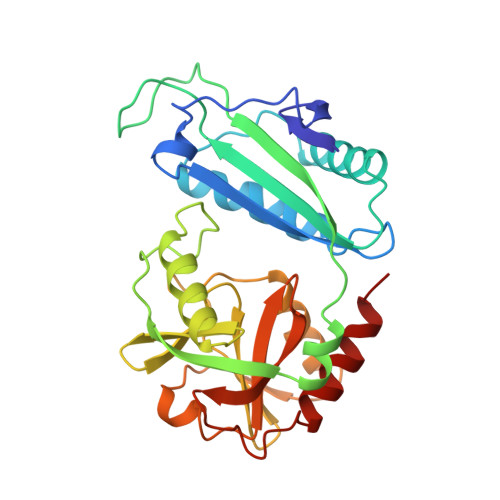Effects of the E177K mutation in D-amino acid transaminase. Studies on an essential coenzyme anchoring group that contributes to stereochemical fidelity.
van Ophem, P.W., Peisach, D., Erickson, S.D., Soda, K., Ringe, D., Manning, J.M.(1999) Biochemistry 38: 1323-1331
- PubMed: 9930994
- DOI: https://doi.org/10.1021/bi982414z
- Primary Citation of Related Structures:
5DAA - PubMed Abstract:
D-Amino acid transaminase is a bacterial enzyme that uses pyridoxal phosphate (PLP) as a cofactor to catalyze the conversion of D-amino acids into their corresponding alpha-keto acids. This enzyme has already been established as a target for novel antibacterial agents through suicide inactivation by a number of compounds. To improve their potency and specificity, the detailed enzyme mechanism, especially the role of its PLP cofactor, is under investigation. Many PLP-dependent transaminases have a negatively charged amino acid residue forming a salt-bridge with the pyridine nitrogen of its cofactor that promotes its protonation to stabilize the formation of a ketimine intermediate, which is subsequently hydrolyzed in the normal transaminase reaction pathway. However, alanine racemase has a positively charged arginine held rigidly in place by an extensive hydrogen bond network that may destabilize the ketimine intermediate, and make it too short-lived for a transaminase type of hydrolysis to occur. To test this hypothesis, we changed Glu-177 into a titratable, positively charged lysine (E177K). The crystal structure of this mutant shows that the positive charge of the newly introduced lysine side chain points away from the nitrogen of the cofactor, which may be due to electrostatic repulsions not being overcome by a hydrogen bond network such as found in alanine racemase. This mutation makes the active site more accessible, as exemplified by both biochemical and crystallographic data: CD measurements indicated a change in the microenvironment of the protein, some SH groups become more easily titratable, and at pH 9.0 the PMP peak appeared around 315 nm rather than at 330 nm. The ability of this mutant to convert L-alanine into D-alanine increased about 10-fold compared to wild-type and to about the same extent as found with other active site mutants. On the other hand, the specific activity of the E177K mutant decreased more than 1000-fold compared to wild-type. Furthermore, titration with L-alanine resulted in the appearance of an enzyme-substrate quinonoid intermediate absorbing around 500 nm, which is not observed with usual substrates or with the wild-type enzyme in the presence of L-alanine. The results overall indicate the importance of charged amino acid side chains relative to the coenzyme to maintain high catalytic efficiency.
- Northeastern University, Boston, Massachusetts 02115, USA.
Organizational Affiliation:

















